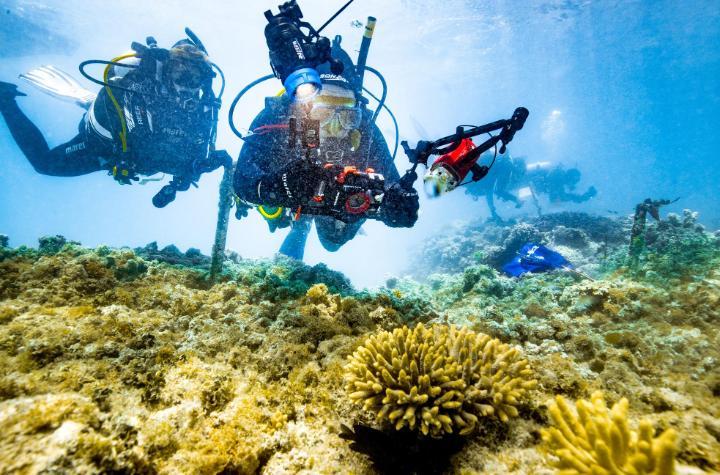First Coral IVF babies on the Great Barrier Reef thriving
Categories
Share
Despite the most widespread bleaching event ever recorded, Southern Cross University researchers have found more than 60 coral colonies, born through the first Coral IVF trial on the Reef in 2016, thriving and likely to spawn next year.
Lead researcher Professor Peter Harrison has just returned from a research trip to Heron Island to check on the progress of the 2016 coral babies and to conduct further Coral IVF trials in the southern Great Barrier Reef.
“I was thrilled to see healthy branching Acropora colonies that are on track to start reproducing themselves in the coral larval restoration sites we settled larvae in four years ago during the first small-scale pilot study,” Professor Harrison said.
“In contrast, sadly, the coral communities in the control sites where we didn’t add any larvae have remained the same and virtually no natural recruitment of new corals has happened in those sites.
“The result of this experiment clearly shows that if we’re going to actively start restoring corals on parts of the Great Barrier Reef we need to supply more coral larvae to enable the coral community to grow fast enough to recover from the damage from recent bleaching events.”
Some of the four-year-old Acropora coral colonies at the larval restoration site in the Heron Island lagoon. Credit: Southern Cross University.
The first Coral IVF trial was made possible with the support of the Great Barrier Reef Foundation.
“Coral IVF is the first project of its kind to re-establish coral on damaged reefs by collecting millions of coral eggs and sperm during the spawning season, growing them into baby corals and releasing them onto degraded areas of the Reef,” said Great Barrier Reef Foundation Managing Director Anna Marsden.
“We couldn’t be more excited to see that these coral babies have grown from microscopic larvae to the size of dinner plates, having not only survived a bleaching event but are now on track to start reproducing themselves – helping restore a degraded reef.”
The Great Barrier Reef is the largest living thing on Earth, with rich corals spanning an area visible from space.
“But it’s facing a growing combination of threats and we need urgent action on climate change while also finding new ways to save coral reefs and help them adapt,” Ms Marsden said.
“Saving the Reef is a huge task, but knowing this innovative, cutting-edge science works gives us hope. After seeing the potential of this game-changing technique the Great Barrier Reef Foundation and its partners brought Coral IVF to the Reef back in 2016 bringing together people and science to give nature a helping hand.”

Professor Peter Harrison and his team visit the Acropora coral larval restoration sites, established in 2016, in the Heron Island lagoon. Credit: Southern Cross University.
Now, as part of the world’s largest coral reefs program, the Reef Restoration and Adaptation Program, this technique is being scaled up with the aim to reach kilometre-scale restoration across the Great Barrier Reef in collaboration with Southern Cross University, CSIRO and QUT, and support from Australian Institute of Marine Science.
“Through the trial which we have just completed with our partners we were able to deploy millions of coral babies to degraded reefs off of Heron and One Tree Islands,” Professor Peter Harrison said.
“We’ve lost so many large breeding corals on many parts of the Great Barrier Reef that the natural production cycle of millions of larvae has started to diminish to the point where very few larvae are now available to settle on reef areas.
“We’re now at a critical time point for understanding how to restore corals on the Great Barrier Reef because each year as sea temperatures continue to rise, the chances of another major bleaching event increase.
"So within the next few years we need to know how to make the larval restoration process more efficient at up-to-kilometre scale so we can start to reverse the trend of declining corals on the Great Barrier Reef,” he said.
The largest floating coral larval nursery pool, a 13-metre octagon, being towed into place in the One Tree Island lagoon. Credit: Southern Cross University.
The Reef Restoration and Adaptation Program
The Reef Restoration and Adaptation Program is funded by the partnership between the Great Barrier Reef Foundation and Australian Government’s Reef Trust and is delivered by a collaboration between Australian Institute of Marine Science, the Great Barrier Reef Foundation, CSIRO, The University of Queensland, QUT, Southern Cross University and James Cook University.

/prod01/channel_8/media/scu-dep/current-students/images/Coffs-harbour_student-group_20220616_33-147kb.jpg)
/prod01/channel_8/media/scu-dep/current-students/services/counselling/images/RS21533_English-College-Student_20191210_DSC_6961-117kb.jpg)
/prod01/channel_8/media/scu-dep/study/scholarships/images/STEPHANIE-PORTO-108-2-169kb.jpg)
/prod01/channel_8/media/scu-dep/study/arts-and-humanities/images/RS20958_Chin-Yung-Pang-Andy_20190309__79I5562-960X540.jpg)
/prod01/channel_8/media/scu-dep/experience/images/SCU-INTNL-STUDY-GUIDE-280422-256-72kb.jpg)
/prod01/channel_8/media/dep-site-assets/component-library/screenshots/online-1X1.jpg)
/484x0:1516x1032/prod01/channel_8/media/scu-dep/news/images/2025/Amanda.jpg)
/250x0:1250x1000/prod01/channel_8/media/scu-dep/news/images/Todd_Thimios_Cocos_Island_Ultimate_Dive_Sites.jpg)
/514x0:1487x973/prod01/channel_8/media/scu-dep/news/images/2025/Humpback-whale_credit-Aurore-Murguet-on-Pexels-2000X973.jpg)
/514x0:1487x973/prod01/channel_8/media/scu-dep/news/images/2025/Dog-labrador-with-a-stick_credit-Mitchell-Orr-on-Unsplash-2000X973.jpg)
/484x0:1516x1032/prod01/channel_8/media/scu-dep/news/images/2025/yasmeen-2.png)
/514x0:1487x973/prod01/channel_8/media/scu-dep/news/images/2025/Sydney-Rock-Oyster-lease-credit-Southern-Cross-University-2000X973.jpeg)
/514x0:1487x973/prod01/channel_8/media/scu-dep/news/images/2023/Shucked-oysters-02_Southern-Cross-University-2000X973.JPG)
/379x0:1352x973/prod01/channel_8/media/scu-dep/news/images/2024/Mahmoud-Abu-Saleem-Andrew-Rose-Joe-Gattas-on-verandah_2024-Dec-3_03-2000X973-135kb.jpg)
/514x0:1487x973/prod01/channel_8/media/scu-dep/news/images/2024/Peter-Harrison-Acropora-valida-spawning-Heron-PH-PC050158-2000X973.jpg)